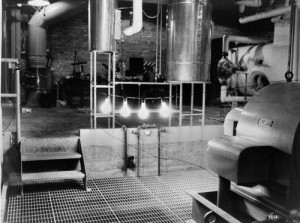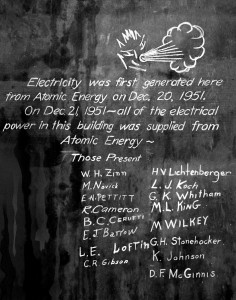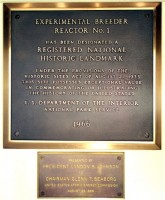EBR-I was not the first nuclear reactor in the U.S. to generate electrical power, that was the X-10 Graphite Reactor at Oak Ridge National Laboratory. The X-10 was used mostly for plutonium production for weapons, and later after the war for radioisotope production for medical facilities. This reactor, dubbed the Experimental Breeder Reactor number 1 (EBR-I), was successful on December 20, 1951, in producing electrical power sufficient to power four 200 watt lightbulbs, as pictured below.

Public Domain, https://commons.wikimedia.org/w/index.php?curid=203080
EBR-I also has the honor of being the world's first "operating breeder reactor," a reactor which produces more fuel for the fission process that it consumes. The breeding process involves creating Plutonium, which can readily fission, from the most abundant isotope of Uranium, which only fissions with high-energy neutrons via neutron bombardment in the reactor. This was at the center of EBR-I's mission, to validate the concept of a breeder reactor that can both maximize the amount of energy obtained from natural uranium, and to demonstrate the great utility and reliability of electrical energy obtained from nuclear fission. After that historic day of illuminating the test lightbulbs, the power output of EBR-I was increased to 100 kilowatts of electric power, making it able to produce enough electricity for its building. The staff members who were present during the historic achievement when power was first generated wrote their names in chalk on the wall next to the generator, which is now viewable to the public.

credit: Argonne National Laboratory

Public Domain, https://commons.wikimedia.org/wiki/File:Ebri_plaques.jpg
On August 26, 1966, President Lyndon Johnson and Dr. Glenn Seaborg, chairman of the Atomic Energy Commission, led a ceremony dedicating the retired reactor as a Registered National Historic Landmark. In his speech to the thousands gathered there, President Johnson echoed themes present in President Dwight Eisenhower's famous Atoms for Peace speech in 1954 to the United Nations: "We have come to a place today where hope was born that man would do more with his discovery [of nuclear fission] than unleash destruction in its wake." In 1973, a plan to open EBR-I to the public, and in 1975 summer tours were first offered for the decommissioned facility. To this day, its legacy lives on in the carbon-free electricity generated by reactors around the globe, and in the immortal words of the former INL director John Grossenbacher: "The history of nuclear energy for peaceful application has principally been written in Idaho".
 Will Searight is a Ph.D. student and graduate research assistant at Penn State, where he studies Plasma-Material Interactions in the Nuclear Thermal Rocket engine. He is involved in Society's Fusion Energy Division (FED), Young Members Group (YMG), Aerospace Nuclear Science & Technology Division (ANSTD), ANS Social Media Team, and the YMG Retention Subcommittee.
Will Searight is a Ph.D. student and graduate research assistant at Penn State, where he studies Plasma-Material Interactions in the Nuclear Thermal Rocket engine. He is involved in Society's Fusion Energy Division (FED), Young Members Group (YMG), Aerospace Nuclear Science & Technology Division (ANSTD), ANS Social Media Team, and the YMG Retention Subcommittee.





 Will Searight is a Ph.D. student and graduate research assistant at Penn State, where he studies Plasma-Material Interactions in the Nuclear Thermal Rocket engine. He is involved in Society's
Will Searight is a Ph.D. student and graduate research assistant at Penn State, where he studies Plasma-Material Interactions in the Nuclear Thermal Rocket engine. He is involved in Society's 





